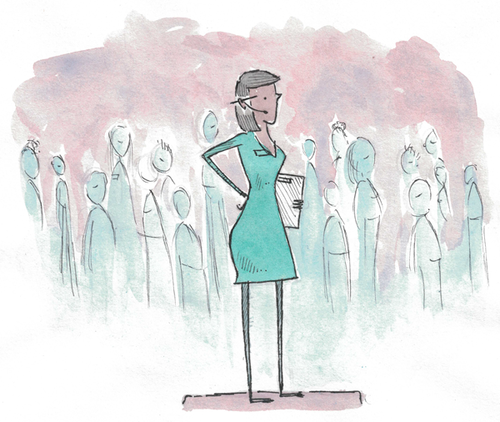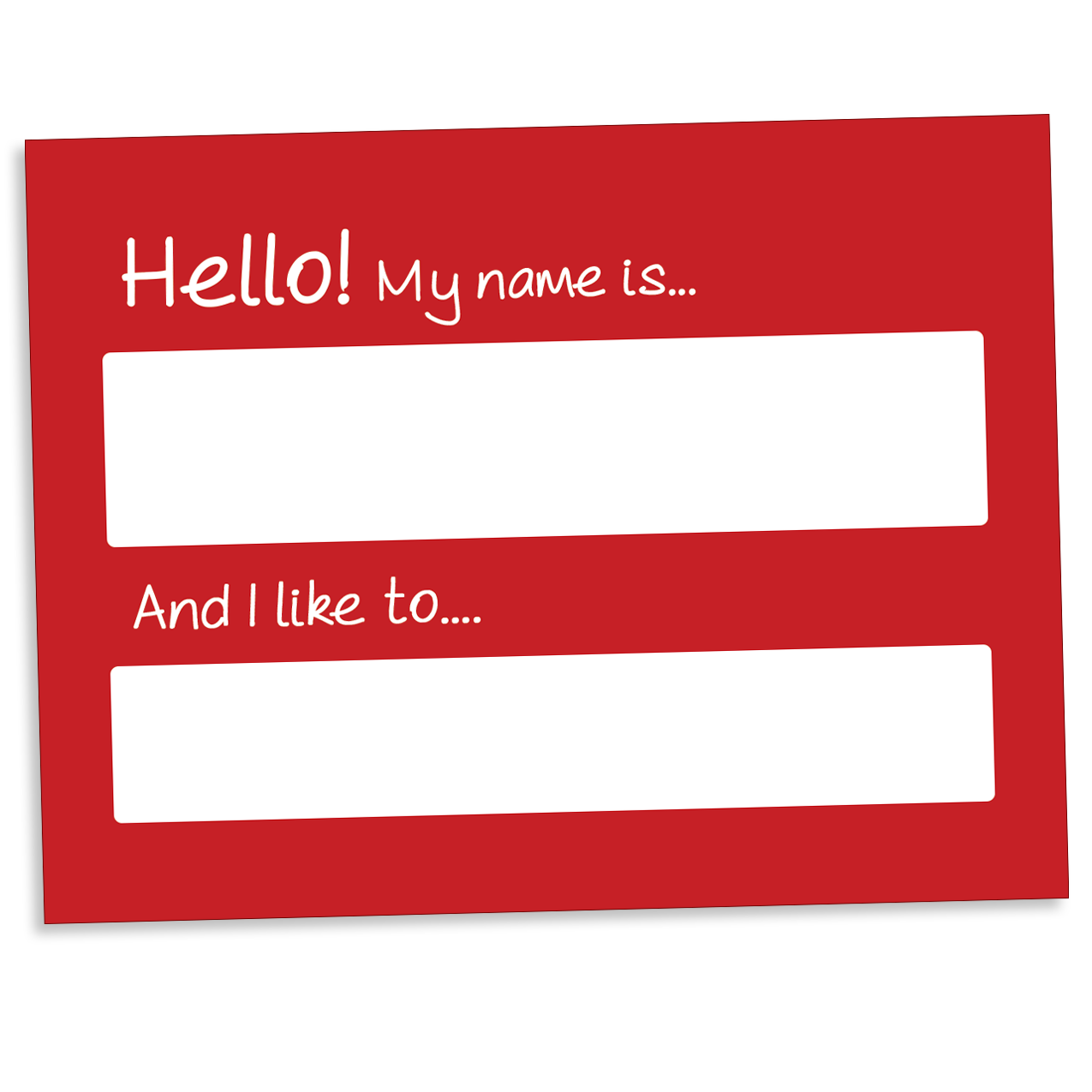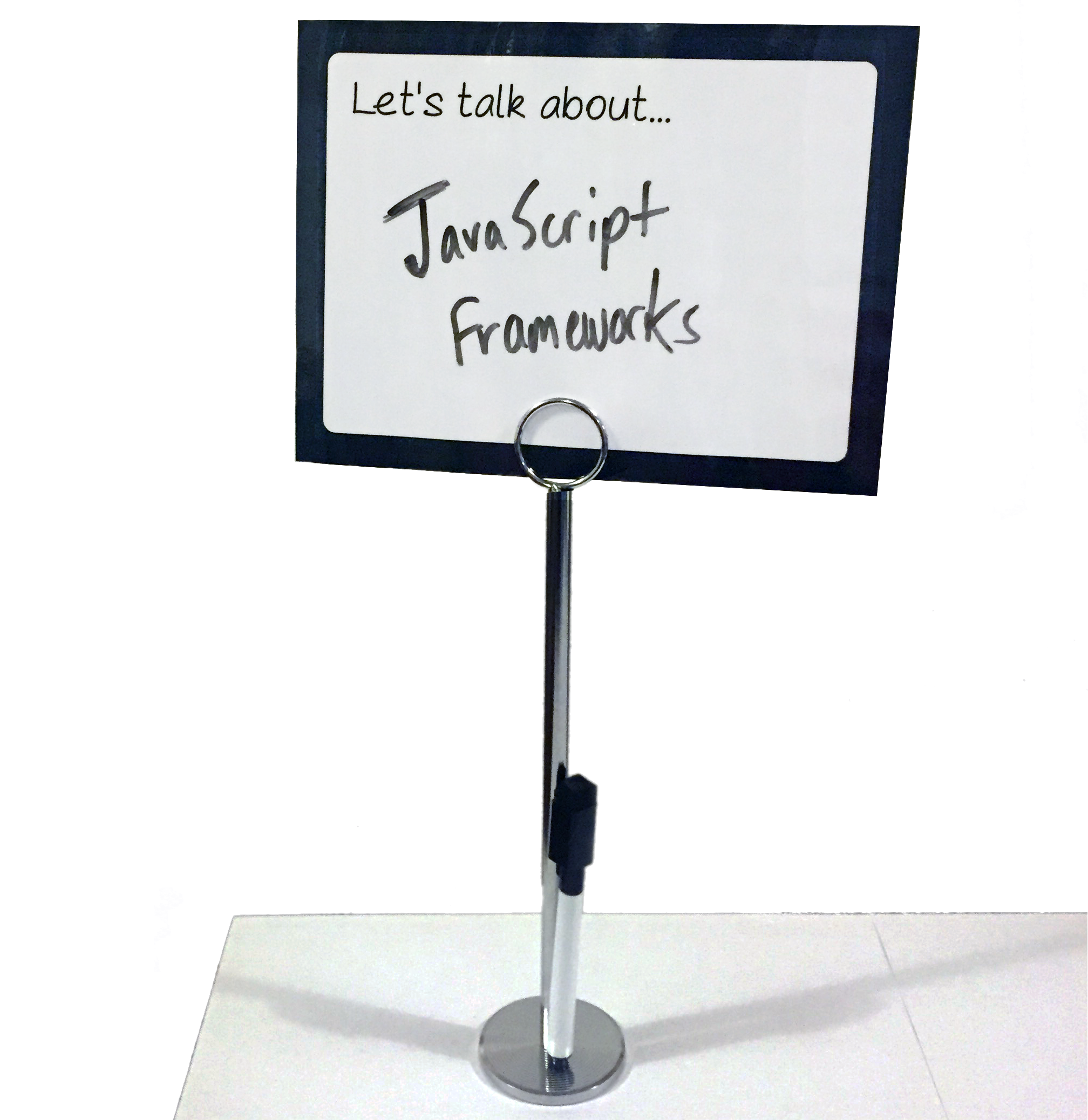Project Icebreak
Ideas for Event Organizers

Organizing an event is hard. You have to think about so many things - marketing, logistics, budget, attendees, speakers. Since you're here on this site, hopefully you're up to adding another item to your list - thinking about how you can make it easier for your attendees to interact with each other. To help you do that, I've put together this list of ways you can achieve that across the whole event experience:
Registration
Name tags:
The standard name tag is just that - a name. That lets your attendees know how to greet each other and remember the names of who they met, but it doesn't do much as a conversation starter. Here are ways you can enhance your name tags:
-
 Encourage attendees to add additional topic keywords/hashtags to their name tag. You can also custom print name tags with a prompt like Hello, and I like.. (like these name tags).
Encourage attendees to add additional topic keywords/hashtags to their name tag. You can also custom print name tags with a prompt like Hello, and I like.. (like these name tags).
- Give attendees stickers and/or buttons to put on their name tags / lanyards for the range of topics that they may be interested in (like these Talk to Me buttons. You can also buy cheap classroom stickers and display a sign with what they mean (e.g. a smiley face for "happy user experiences", a monkey for "code monkey", a spider for "webmaster").
- Provide name tags in different colors for different personality types. At an Autism conference, the red name tags signaled "Don't approach me for socialization", the green tags signaled "Please approach me because I want to talk to people but have a hard time initiating socialization," and neutral tags signaled "I wouldn't mind talking to you but you don't have to go out of your way to talk to me."
- If you're printing the name tags before hand, you can match each attendee with 2 other attendees, and put the names of them on the name tag. As a bonus, pick those names programmatically based on interests expressed in registration.
Collectibles:
You could give each person a set of small collectible items, like a set of buttons about a particular conference topic or cards with the speaker's faces. Distribute different sets so that people are encouraged to ask for collectibles from each other to vary their set.
Room Setup
Seating:
The standard conference room setup is rooms of chairs. However, that option is the worst for encouraging attendee interaction. First, that layout visually enforces the idea that the audience is there only to watch and interact with the speaker - not with everyone else in the room. Second, people often avoid sitting right next to each other until the room is packed (due to societal norms). Finally, there's just something awkward about turning your head completely to explicitly start a conversation with a stranger-neighbor. Even if attendees do get to chatting, there's a max of two people (one on each side) that they'll interact with.
Instead, consider oval tables (like these from Webstock). The oval tables encourage interaction because attendees are naturally looking at each other while also making it easy to comfortably watch the speakers.
Conversation pieces:
Sometimes attendees still need a little help in starting up conversation. If you're using tables for seating, you can put centerpieces on the table to help - like a box of relevant facts/quizzes/questions or a collection of little puzzles/toys. If your seating is rows of chairs, then you can tape conversation questions to the back of each chair (“Ask the person next to you the last place they traveled to”).
Scheduling
Breaks:
Don't do a continuous stream of talks all day. Have at least a brief break after each talk, and have a longer 15-break every 1-2 hours, ideally with snacks. It gives people a chance to discuss what they just saw and possibly meet new people.
More speakers:
An attendee often finds it easier to approach a speaker than a random other attendee, because they know a lot about the speaker and can ask them a specific question. Thus, when your conference has more speakers, there are more people that are easier to approach. You can increase the number of speakers at your conference by holding a lightning talks session (and even do sign-ups at the event itself) or carving out time and space for attendee-led Birds of a Feather (BoF) sessions.
Meet your neighbor:
At the beginning of the conference or even at the beginning of each talk, give the attendees 5 minutes to meet their neighbor, and give them a specific question like "What's the last app you coded?" or "What's something new you learned this month?"
Networking Events
Many conferences have time carved out in their schedule for "networking" or "mingling", and all they provide is a room and snacks. Here are ways you can add structure to those events, from least to most effort:
Introductions:
At a small, intimate event, you might actually have the time to do a full round of introductions. The introduction should include their name plus additional fodder for conversation - like what they do and why they're there. If you have time, they can also answer a creative question like "what's your spirit animal?" I always do a full round of introductions for events with less than 50 attendees and I've even been at a conference that did a rapid-fire version (name plus 3 keywords) for a room of 300.
Call for plugs:
Once a networking event is fully under way, an MC can grab a mic, hush the room, and encourage anyone to express what they're looking for - e.g. looking for a job, looking to hire, looking for a co-founder, looking for collaborators. This structure works best at an event that has too many people to do a full round of introductions and likely has a lot of folks that fall into the "looking for something" category.
Networking bingo:
This game is a fun way for attendees to say a few sentences to a couple dozen others (e.g. "Do you have a tattoo?" or "Have you ever been to Europe?"). To run it, create a networking bingo board (like this one), print out enough copies for your attendees, distribute the boards with pens at the event and give them a deadline for completing the boards. You can also give a fun little prize if you collect all the boards in a box and pull one out at random. I love running this game at the beginning of an event, as it keeps early attendees occupied while waiting for the rest to arrive and starts the event on a social note.
Speed networking:
Based on speed dating, the general idea behind speed networking is to give attendees a few minutes with another attendee, enough time to figure out if they'd want to chat later. Here are two variations of many:
- Randomized: An MC starts by instructing each person to find someone they don't know yet, and who appears dissimilar to you in some way (or even "the opposite of you"). Then the MC gives each pair 1 minute each to introduce themselves, and then 2 minutes each to answer a particular question. That question can be related to the event ("What's the last thing you coded?") or a personal inquiry ("What are your favorite weekend activities?").
- Pre-matched: This version is a lot more work but worth it if you can pull it off. When your attendees register, ask them to select their top 5 interests out of a list of conference-relevant topics. Figure out how many pairs of chairs you'll set out for networking the session (# of attendees / 2) and assign a number to each pair. Write a program that comes up with pairs of attendees based on interests and assigns them to a pair of seats, and does that for however many rounds you want to run (~8). Print the sequence of pair #s on the back of each attendee's lanyard. Call all the attendees to the session at the scheduled time and have them sit according to the first assigned pair number. Set a timer for each pair to chat between 5-10 minutes, and then get everyone to sit in their next assignment. Pre-matching is great because it increases the likelihood of people finding alike people, but there are a few (surmountable!) logistical hurdles. If an attendee doesn't show up, then their abandoned partner can triple up with the closest pair--that works as long as most attendees show up. If an attendee registers late, then they can grab the lanyard of a no-show attendee.
After parties
Many conferences hold after-parties at bars and hope that free alcohol will provide all the social lubrication that attendees need to get to know each other. It's true that alcohol helps us be more social by lowering our inhibitions, but there are drawbacks to over-reliance on alcohol: 1) many people don't drink alcohol for a variety of reasons 2) too much inhibition-lowering can lead to boundary-crossing and code of conduct violations. So how can you put on an after-party where people *can* get to know each other without needing alcohol? Here are a few ideas:
Venue Setup
-
Provide an "un-bar" - another room with a bar serving tea, juice, shakes, hot cocoa.
-
If you do also provide a standard bar, consider giving each person a certain number of alcohol tokens and ask bartenders to watch for people cheating that system.
-
Keep the music volume low enough so that people can easily hear each other. Remember that your attendees may be from foreign countries or talking to people with accents different from theirs, so they don't need the extra obstacle of struggling to hear someone while also getting to know them.
-
Don't overfill the venue so that there's barely any space to move - that makes it harder for people to end conversations and find new people to meet.
Conversation Starters
When you're not relying on alcohol for networking, it's even more important for an after-party to include conversation starters such as:
- Badged name badges: Make sure attendees still have name tags that are more than just their name, like I described in the beginning.
- Networking bingo: An after-party is another place that you can play the networking bingo game described above.
- Conversation Cards: Give cards of questions to attendees at the door. To avoid them coming across as lame, the questions could be fun what-if style questions and vary per person. Alternatively, you can stick with lame and watch attendees bond over the lame-ness of it.
-
 Tribe Tables: This is more for conference mealtimes than for after-parties, but you can do it wherever you have people sitting around tables. Figure out topics that interest your conference attendees (like based on the tracks or talks) and then put a big sign at each table declaring its topic. People will sit at the table who are interested in what's on the sign, and they'll have a more specific thing to talk about with each other. Alternatively, you can use customizable Let's Talk signs and let attendees suggest the topics themselves.
Tribe Tables: This is more for conference mealtimes than for after-parties, but you can do it wherever you have people sitting around tables. Figure out topics that interest your conference attendees (like based on the tracks or talks) and then put a big sign at each table declaring its topic. People will sit at the table who are interested in what's on the sign, and they'll have a more specific thing to talk about with each other. Alternatively, you can use customizable Let's Talk signs and let attendees suggest the topics themselves.
Bonding Activities
Some attendees will be excited to converse with each other - but others might be exhausted by conversation and crave other ways to interact. Here are some that I've enjoyed at conferences:
Fun & Games
- Trivia Night: This takes a bit of effort but can be well worth it. Create trivia questions that are topical to the conference, organize people into random teams, and have them compete to win some pile of schwag. To increase the number of teams that feel like winners, offer bonus questions throughout the night, or superlatives like "Best Team Spirit."
- Poker/Casino Games: These can be fun and there are companies that will put on poker nights for you. Don't involve real money, though - just start everyone off with a certain amount of tokens and make it tradeable for schwag at the end.
- Board Games: Offer a range of games - strategic games like Coup, Dominion, and Settlers and "party games" genre like Pictionary, Charades, Catchphrase, and Balderdash.
- Parlour Games: A personal favorite is WereWolf/Mafia-- I've spent many nights of my life playing WereWolf until 3am at conferences. You've never bonded with someone until you've looked them in the eye and accused them of being a blood-thirsty werewolf. A game is 12-20 people, so allocate conference rooms for the number of games you expect.
- Jenga: You can scatter Jenga games throughout a bar or invest in giant Jengas. It's a familiar game that's quick and fun to play.
Arts & Crafts
- Drawing: Instead of tablecloths on your tables, do what many restaurants do and cover them in butcher paper with crayons nearby. People can doodle as they chat, and chat about their doodles. You can refresh the butcher paper throughout the night when it gets covered, and stick the creations on the walls for passerbys to chat about. You can also write topical themes on the paper to inspire their drawings.
- Crafts: At the Japanese-themed Heroku Waza conference, they had tables in the open area where you could do origami or linoleum cutting along with pros. It was a fun way to spend 30 minutes and bond over what we were making. Other fun crafts: boondoggle, friendship bracelets, sand art, finger painting, etc.
- MakerBots: The FooCamp conference often includes a room with MakerBots where you couldget your face scanned in 3d and wait for a print-out of the face. People love seeing the technology and talking about how it works - but only a few people can do it at a time. It's a fun side booth for a technical conference. Many Maker Faire exhibits are good additions to a technical conference, in fact, so Google I/O often feature the most fun and interactive ones for their after-party.
Getting Physical
After a day of sitting in rooms, some attendees will be itching to move around - so they might be most excited by a physical activity. Keep in mind your liability if someone gets hurt, and for activities where people's bodies are mingling, remember that not everyone will be comfortable with that. Consider what will work best for your crowd, and of course, every activity you offer should be optional.
- Twister: At a retreat I ran in college, we used to set up giant games of Twister using paper plates colored with markers, so quite a few people could play at once. Ridiculous but fun.
- Adult Hippity-Hop: Bring back the simple childhood joy of hopping around on a giant ball.
- Floating Ball: Much of the mingling at FooCamp happens outdoors, so they sprinkled huge LED-lit floating balls around the lawn for attendees to play keep-away with.
Do you have other ideas for this list? Send a pull request or issue on Github. Thanks!